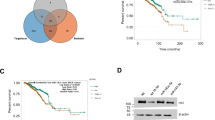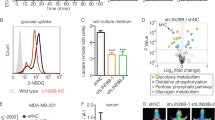Abstract
Increasing evidence confirmed that the Warburg effect plays an important role involved in the progression of malignant tumors. Resibufogenin (RES) has been proved to have a therapeutic effect in multiple malignant tumors. However, the mechanism of whether RES exerted an antitumor effect on breast cancer through regulating the Warburg effect is largely unknown. The effect of RES on glycolysis was determined by glucose consumption, lactate production, ATP generation, extracellular acidification rate and oxygen consumption rate in breast cancer cells. The total RNA and protein levels were respectively measured by RT-qPCR and western blot. Cell proliferation and apoptosis were examined using the CCK-8 assay, colony formation assay, and flow cytometry, respectively. The interaction between miR-143-3p and HK2 was verified by dual-luciferase reporter gene assay. We also evaluated the influence of RES on the tumor growth and Warburg effect in vivo. RES treatment significantly decreased glycolysis, cell proliferation and induced apoptosis of both MDA-MB-453 and MCF-7 cells. Simultaneously, the expression of HK2 was decreased in breast cancer cells treated with RES, which was positively associated with tumor size and glycolysis. Moreover, HK2 was a direct target gene of miR-143-3p. Mechanistically, upregulation of miR-143-3p by RES treatment inhibited tumor growth by downregulating HK2-mediated Warburg effect in breast cancer. Our findings suggested that RES exerted anti-tumorigenesis and anti-glycolysis activities in breast cancer through upregulating the inhibitory effect of miR-143-3p on HK2 expression, which provided a new potential strategy for breast cancer clinical treatment.







Similar content being viewed by others
Change history
13 September 2022
This article has been retracted. Please see the Retraction Notice for more detail: https://doi.org/10.1007/s11010-022-04560-8
References
Woolston C (2015) Breast cancer. Nature 527:S101
Peart O (2015) Breast intervention and breast cancer treatment options. Radiol Technol 86:535–558
Harbeck N, Gnant M (2017) Breast cancer. Lancet (Lond, Engl) 389:1134–1150
Davoodvandi A, Sahebnasagh R, Mardanshah O, Asemi Z, Nejati M, Shahrzad MK, Mirzaei HR, Mirzaei H (2019) Medicinal plants as natural polarizers of macrophages: phytochemicals and pharmacological effects. Curr Pharm Des 25:3225–3238
Yu E, Xu Y, Shi Y, Yu Q, Liu J, Xu L (2019) Discovery of novel natural compound inhibitors targeting estrogen receptor alpha by an integrated virtual screening strategy. J Mol Model 25:278
Xie RF, Li ZC, Gao B, Shi ZN, Zhou X (2012) Bufothionine, a possible effective component in cinobufocini injection for hepatocellular carcinoma. J Ethnopharmacol 141:692–700
Li Q, Jiang C, Wang Y, Wei M, Zheng H, Xu Y, Xu X, Jia F, Liu K, Sun G, Zang J, Mo P (2019) Resibufogenin suppresses tumor growth and inhibits glycolysis in ovarian cancer by modulating PIM1. Naunyn-Schmiedeberg's Arch Pharmacol 392:1477–1489
Qi F, Li A, Inagaki Y, Kokudo N, Tamura S, Nakata M, Tang W (2011) Antitumor activity of extracts and compounds from the skin of the toad Bufo bufo gargarizans Cantor. Int Immunopharmacol 11:342–349
Liu L, Liu Y, Liu X, Zhang N, Mao G, Zeng Q, Yin M, Song D, Deng H (2018) Resibufogenin suppresses transforming growth factor-beta-activated kinase 1-mediated nuclear factor-kappaB activity through protein kinase C-dependent inhibition of glycogen synthase kinase 3. Cancer Sci 109:3611–3622
Matsuura K, Canfield K, Feng W, Kurokawa M (2016) Metabolic regulation of apoptosis in cancer. Int Rev Cell Mol Biol 327:43–87
Li C, Zhang G, Zhao L, Ma Z, Chen H (2016) Metabolic reprogramming in cancer cells: glycolysis, glutaminolysis, and Bcl-2 proteins as novel therapeutic targets for cancer. World J Surg Oncol 14:15
Wang Z, Wang N, Chen J, Shen J (2012) Emerging glycolysis targeting and drug discovery from chinese medicine in cancer therapy. eCAM 2012:873175
Jin J, Qiu S, Wang P, Liang X, Huang F, Wu H, Zhang B, Zhang W, Tian X, Xu R, Shi H, Wu X (2019) Cardamonin inhibits breast cancer growth by repressing HIF-1alpha-dependent metabolic reprogramming. J Exp Clin Cancer Res 38:377
Li Y, Xu Q, Yang W, Wu T, Lu X (2019) Oleanolic acid reduces aerobic glycolysis-associated proliferation by inhibiting yes-associated protein in gastric cancer cells. Gene 712:143956
Pan Y, Wang W, Huang S, Ni W, Wei Z, Cao Y, Yu S, Jia Q, Wu Y, Chai C, Zheng Q, Zhang L, Wang A, Sun Z, Huang S, Wang S, Chen W, Lu Y (2019) Beta-elemene inhibits breast cancer metastasis through blocking pyruvate kinase M2 dimerization and nuclear translocation. J Cell Mol Med 23:6846–6858
Knobloch TJ, Ryan NM, Bruschweiler-Li L, Wang C, Bernier MC, Somogyi A, Yan PS, Cooperstone JL, Mo X, Bruschweiler RP, Weghorst CM, Oghumu S (2019) Metabolic regulation of glycolysis and AMP activated protein kinase pathways during black raspberry-mediated oral cancer chemoprevention. Metabolites. https://doi.org/10.3390/metabo9070140
Bonatelli M, Silva ECA, Carcano FM, Zaia MG, Lopes LF, Scapulatempo-Neto C, Pinheiro C (2019) The Warburg effect is associated with tumor aggressiveness in testicular germ cell tumors. Frontiers in endocrinology 10:417
Zhao X, Zhang T, Jiang K, Gao H (2019) Alpinumisoflavone exhibits anti-cancer activities in glioblastoma multiforme by suppressing glycolysis. Anat Record. https://doi.org/10.1002/ar.24242
Tian Y, Chen YY, Han AL (2019) MiR-1271 inhibits cell proliferation and metastasis by targeting LDHA in endometrial cancer. Eur Rev Med Pharmacol Sci 23:5648–5656
Nagarajan A, Dogra SK, Sun L, Gandotra N, Ho T, Cai G, Cline G, Kumar P, Cowles RA, Wajapeyee N (2017) Paraoxonase 2 facilitates pancreatic cancer growth and metastasis by stimulating GLUT1-mediated glucose transport. Mol Cell 67:685–701.e686
Liu K, Gao H, Wang Q, Wang L, Zhang B, Han Z, Chen X, Han M, Gao M (2018) Hispidulin suppresses cell growth and metastasis by targeting PIM1 through JAK2/STAT3 signaling in colorectal cancer. Cancer Sci 109:1369–1381
Song W, Wang Z, Gu X, Wang A, Chen X, Miao H, Chu J, Tian Y (2019) TRIM11 promotes proliferation and glycolysis of breast cancer cells via targeting AKT/GLUT1 pathway. OncoTargets Therapy 12:4975–4984
Wu Z, Wu J, Zhao Q, Fu S, Jin J (2019) Emerging roles of aerobic glycolysis in breast cancer. Clin Trans Oncol. https://doi.org/10.1007/s12094-019-02187-8
Marchetti P, Trinh A, Khamari R, Kluza J (1862) Melanoma metabolism contributes to the cellular responses to MAPK/ERK pathway inhibitors. Biochim Biophys Acta 2018:999–1005
Shahruzaman SH, Fakurazi S, Maniam S (2018) Targeting energy metabolism to eliminate cancer cells. Cancer Manag Res 10:2325–2335
Wu J, Hu L, Wu F, Zou L, He T (2017) Poor prognosis of hexokinase 2 overexpression in solid tumors of digestive system: a meta-analysis. Oncotarget 8:32332–32344
Fan K, Fan Z, Cheng H, Huang Q, Yang C, Jin K, Luo G, Yu X, Liu C (2019) Hexokinase 2 dimerization and interaction with voltage-dependent anion channel promoted resistance to cell apoptosis induced by gemcitabine in pancreatic cancer. Cancer Med 8:5903–5915
Tao F, Zhang Y, Zhang Z (2019) The role of herbal bioactive components in mitochondria function and cancer therapy. eCAM 2019:3868354
Zhan X, Wu H, Wu H, Wang R, Luo C, Gao B, Chen Z, Li Q (2019) Natural active constituents of Bufo bufo gargarizans cantor: a review on pharmacological activity, toxicity and quality control. J Ethnopharmacol 246:112178
Schmeda-Hirschmann G, Quispe C, Arana GV, Theoduloz C, Urra FA, Cardenas C (2016) Antiproliferative activity and chemical composition of the venom from the Amazonian toad Rhinella marina (Anura: Bufonidae). Toxicon 121:119–129
Ichikawa M, Sowa Y, Iizumi Y, Aono Y, Sakai T (2015) Resibufogenin induces G1-phase arrest through the proteasomal degradation of cyclin D1 in human malignant tumor cells. PLoS ONE 10:e0129851
Han Q, Ma Y, Wang H, Dai Y, Chen C, Liu Y, Jing L, Sun X (2018) Resibufogenin suppresses colorectal cancer growth and metastasis through RIP3-mediated necroptosis. J Trans Med 16:201
Hua Q, Mi B, Huang G (2018) The emerging co-regulatory role of long noncoding RNAs in epithelial-mesenchymal transition and the Warburg effect in aggressive tumors. Critic Rev Oncol/Hematol 126:112–120
Thorne JL, Campbell MJ (2015) Nuclear receptors and the Warburg effect in cancer. Int J Cancer 137:1519–1527
Brodsky AN, Odenwelder DC, Harcum SW (2019) High extracellular lactate causes reductive carboxylation in breast tissue cell lines grown under normoxic conditions. PLoS ONE 14:e0213419
Yao L, Wang L, Cao ZG, Hu X, Shao ZM (2019) High expression of metabolic enzyme PFKFB4 is associated with poor prognosis of operable breast cancer. Cancer Cell Int 19:165
Gong W, Yang L, Wang Y, Xian J, Qiu F, Liu L, Lin M, Feng Y, Zhou Y, Lu J (2019) Analysis of survival-related lncRNA landscape identifies a role for LINC01537 in energy metabolism and lung cancer progression. Int J Mol Sci. https://doi.org/10.3390/ijms20153713
Jiang D, Zhang Y, Yang L, Lu W, Mai L, Guo H, Liu X (2019) Long noncoding RNA HCG22 suppresses proliferation and metastasis of bladder cancer cells by regulation of PTBP1. J Cell Physiol 235:1711–1722
Yang J, Ren B, Yang G, Wang H, Chen G, You L, Zhang T, Zhao Y (2019) The enhancement of glycolysis regulates pancreatic cancer metastasis. Cell Mol Life Sci 77:305–321
Luo P, Zhang C, Liao F, Chen L, Liu Z, Long L, Jiang Z, Wang Y, Wang Z, Liu Z, Miao H, Shi C (2019) Transcriptional positive cofactor 4 promotes breast cancer proliferation and metastasis through c-Myc mediated Warburg effect. Cell Commun Signal 17:36
Ye J, Zou M, Li P, Liu H (2018) MicroRNA regulation of energy metabolism to induce chemoresistance in cancers. Technol Cancer Res Treat 17:1533033818805997
Shankaraiah RC, Veronese A, Sabbioni S, Negrini M (2018) Non-coding RNAs in the reprogramming of glucose metabolism in cancer. Cancer Lett 419:167–174
Guda MR, Asuthkar S, Labak CM, Tsung AJ, Alexandrov I, Mackenzie MJ, Prasad DV, Velpula KK (2018) Targeting PDK4 inhibits breast cancer metabolism. Am J Cancer Res 8:1725–1738
Eastlack SC, Dong S, Ivan C, Alahari SK (2018) Suppression of PDHX by microRNA-27b deregulates cell metabolism and promotes growth in breast cancer. Mol Cancer 17:100
Li L, Kang L, Zhao W, Feng Y, Liu W, Wang T, Mai H, Huang J, Chen S, Liang Y, Han J, Xu X, Ye Q (2017) miR-30a-5p suppresses breast tumor growth and metastasis through inhibition of LDHA-mediated Warburg effect. Cancer Lett 400:89–98
Zheng X, Zhou Y, Chen W, Chen L, Lu J, He F, Li X, Zhao L (2018) Ginsenoside 20(S)-Rg3 Prevents PKM2-Targeting miR-324-5p from H19 sponging to antagonize the Warburg effect in ovarian cancer cells. Cell Physiol Biochem 51:1340–1353
Zhou Y, Zheng X, Lu J, Chen W, Li X, Zhao L (2018) Ginsenoside 20(S)-Rg3 inhibits the Warburg effect via modulating DNMT3A/ MiR-532-3p/HK2 pathway in ovarian cancer cells. Cell Physiol Biochem 45:2548–2559
Funding
None.
Author information
Authors and Affiliations
Corresponding author
Ethics declarations
Conflict of interests
The authors declare that they have no conflict of interest.
Additional information
Publisher's Note
Springer Nature remains neutral with regard to jurisdictional claims in published maps and institutional affiliations.
This article has been retracted. Please see the retraction notice for more detail: https://doi.org/10.1007/s11010-022-04560-8
Rights and permissions
Springer Nature or its licensor holds exclusive rights to this article under a publishing agreement with the author(s) or other rightsholder(s); author self-archiving of the accepted manuscript version of this article is solely governed by the terms of such publishing agreement and applicable law.
About this article
Cite this article
Guo, Y., Liang, F., Zhao, F. et al. RETRACTED ARTICLE: Resibufogenin suppresses tumor growth and Warburg effect through regulating miR-143-3p/HK2 axis in breast cancer. Mol Cell Biochem 466, 103–115 (2020). https://doi.org/10.1007/s11010-020-03692-z
Received:
Accepted:
Published:
Issue Date:
DOI: https://doi.org/10.1007/s11010-020-03692-z




